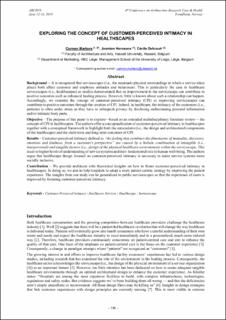| dc.contributor.author | Martens, Carmen | |
| dc.contributor.author | Herssens, Jasmien | |
| dc.contributor.author | Delcourt, Cécile | |
| dc.date.accessioned | 2021-12-28T12:05:23Z | |
| dc.date.available | 2021-12-28T12:05:23Z | |
| dc.date.issued | 2021 | |
| dc.identifier.isbn | 978-82-536-1718-3 | |
| dc.identifier.issn | 2387-4295 | |
| dc.identifier.uri | https://hdl.handle.net/11250/2835516 | |
| dc.description.abstract | Background —It is recognized that servicescapes (i.e., the manmade physical surroundings in which a service takes place) both affect customer and employee attitudes and behaviours. This is particularly the case in healthcare servicescapes (i.e., healthscapes) as studies demonstrated that an improvement in the servicescape can contribute to positive outcomes such as enhanced healing process. However, little is known about such a relationship can happen. Accordingly, we examine the concept of customer-perceived intimacy (CPI) as improving servicescapes can contribute to positive outcomes through the creation of CPI. Indeed, in healthcare, the intimacy of the customers (i.e., patients) is often under stress as they have to relinquish privacy by disclosing embarrassing personal information and/or intimate body parts.
Objective – The purpose of this paper is to explore—based on an extended multidisciplinary literature review— the concept of CPI in healthscapes. The authors offer a conceptualization of customer-perceived intimacy in healthscapes together with a conceptual framework to highlight both the antecedents (i.e., the design and architectural components of the healthscape) and the short-term and long-term outcomes of CPI.
Results – Customer-perceived intimacy defined as “the feeling that combines the dimensions of mutuality, discovery, emotions and kindness, from a customer's perspective” are caused by a holistic combination of intangible (i.e., interpersonal) and tangible factors (i.e., design of the physical healthcare environment) within the servicescape. This leads to higher levels of understanding of service systems and their fundamental role in human well-being. The authors argue that healthscape design focused on customer-perceived intimacy is necessary to make service systems more socially inclusive.
Contribution – We provide architects with theoretical insights on how to foster customer-perceived intimacy in healthscapes. In doing so, we aim to help hospitals to adopt a more patient-centric strategy by improving the patient experience. The insights from our study can be generalized to public servicescapes so that the experience of users is improved by fostering customer-perceived intimacy. | |
| dc.language.iso | eng | |
| dc.publisher | SINTEF Academic Press | |
| dc.relation.ispartof | ARCH19 June 12–13, 2019 – Trondheim, Norway. Proceedings from the 4th Conference on Architecture Research Care & Health | |
| dc.relation.ispartofseries | SINTEF Proceedings;8 | |
| dc.rights | CC BY 4.0 | |
| dc.rights.uri | https://creativecommons.org/licenses/by/4.0/ | |
| dc.subject | Customer-Perceived Intimacy | |
| dc.subject | Healthcare Services | |
| dc.subject | Healthscape | |
| dc.subject | Servicescape | |
| dc.title | Exploring the Concept of Customer-Perceived Intimacy in Healthscapes | |
| dc.type | Chapter | |
| dc.type | Peer reviewed | |
| dc.type | Conference object | |
| dc.description.version | publishedVersion | |
| dc.rights.holder | © 2021 The Authors. | |
| dc.subject.nsi | VDP::Medisinske Fag: 700::Helsefag: 800 | |

